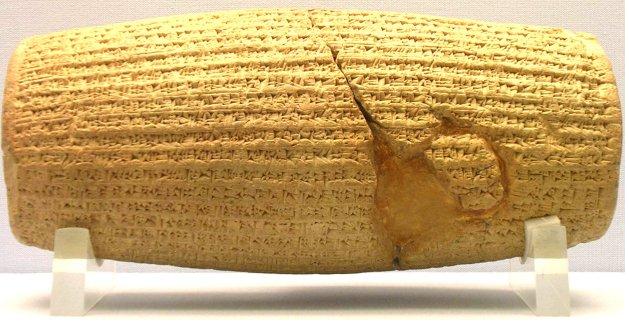An interesting article by Shimon D. Cohen on the London-based CAIS website discusses the history of Cyrus the Great and his legacy to the present day. Cohen’s article was written in the context of the Exhibition of ‘The Cyrus Cylinder and Ancient Persia’ which opened on Saturday 9th March, 2013. The exhibition displays carvings, plaques, architectural works and luxury objects. The exhibition opened in Washington D.C. at the Smithsonian’s Arthur M. Sackler Gallery on March 9 and will continue through until April 28. After the display at the Sackler gallery, the Cyrus Cylinder will be bought over to the Museum of Fine Arts in Houston, The Metropolitan Museum of Art in New York and the Asian Art Museum in San Francisco. The Cylinder will then conclude its North American trek at the J. Paul Getty Museum at the Getty Villa in Los Angeles in October 2013.

The Cyrus Cylinder now housed in The British Museum. The policies advocated by Cyrus in this Cylinder are corroborated by independent Greek and Biblical sources as well as by a number of other archaeological findings in Mesopotamia (modern Iraq), Egypt and western Anatolia (in Modern Turkey).
The Exhibition is being supported by the British museum and sponsored by members of the Iranian diaspora — especially the Iran Heritage Foundation.
Cohen’s article also discusses political lobbies opposed to the legacy of the Cyrus Cylinder, especially Eurocentrists and Pan-Islamists:
“Outside Iran, the regime has also hired a number of foreigners to attack Cyrus the Great’ historical figure – some of which claim Cyrus was not even a Persian. It is alleged, that a well known among them is a pseudo-historian who calls himself Jona Lendering, and runs a blog that provides the most biased and inaccurate information about pre-Islamic Iran. It is believed that the majority of the Wikipedia articles concerning the Achaemenid history, particularly those referenced to Cyrus the Great, has been edited by Lendering. To back his propaganda, he references all the entries – majority back to his blog ‘Livius.org’, or other likeminded blogs and websites. It was also alleged a few years ago that the Islamic republic has opened an office for him in Central Tehran and put him on their pay list for his supererogatory services. To promote himself as a ‘historian’, one of his friends even created a page in Wikipedia. He also began a hate campaign against those Iranian academics not favoured by the Islamic Republic, who are living outside Iran and are expert in Pre-Islamic Iranian history, in particular Dr Kaveh Farrokh. Lendering also succeeded to influence two prominent European newspapers; Der Spiegel and the Daily Telegraph which have fallen for his propaganda and began a hate campaign against Cyrus the Great and ancient Persia.
A Persian Rabbi in 2008 accused Der Spiegel of inciting anti-Semitism and called for a legal action against the editor. Rabbi Yohanna Hamadani described the article as a “dark coalition of anti-Semitic-Neo-Nazis, Cohen has aptly summarized how historical icons can become politicized. Before attacking Kaveh Farrokh, Jona Lendering first sold his pictures for Farrokh’s text Shadows in the Desert (2007) to Osprey Publishing. Mr. Lendering received money for his pictures published in pages 23, 53, 54, 89, 116, 128, 179, 180, 181, 183, 189, 195, 225, and 288 – After receiving payment Mr. Lendering launched ad hominem attacks against Kaveh Farrokh on Wikipedia, the internet (in Dutch and English) with the support of Dr. Wouter Henkelman, Dr. Amelie Kuhrt, Dr. Pierre Briant and Dr. Matt Stolper and their backers in the internet and Wikipedia (many based in Iran, Bosnia and Russia and posing as westerners). NOTE: Farrokh had never written against any of these individuals or Mr. Lendering (or Livius.org). Cohen’s article has identified the reason for these attacks: Farrokh was being “punished” for daring to contradict the post-1979 (revisionist) narratives against Cyrus the Great. Jona “Tehran” Lendering (left) and one of his defamatory-attack victims, Iranian historian Shapour Suren-Pahlav (right) who is also host of the Circle of Ancient Iranian Studies (CAIS) in London which provides resources for learning about ancient Iran. Lendering used his Wikipedia supporters and administrators to forcefully eject CAIS postings regarding Cyrus the Great out of the Wikipedia in 2007-2009. The reason: Mr. Lendering’s perspective that the Human Rights legacy of Cyrus the Great is “Shah propaganda”. Even more bizarre are Lendering’s attacks against Shapour-Suren Pahlav for raising alarm bells regarding the destruction of historical sites (including UNESCO sites) in Iran. Lendering has even attempted to whitewash reports that the Sivand Dam is harmful to Cyrus’ tomb at Pasargad by labelling this as ”anti-Iranian propaganda“! A number of Eurocentric Assyriologists and their supporters inside the Iranian establishment support Jona Lendering’s narratives.





